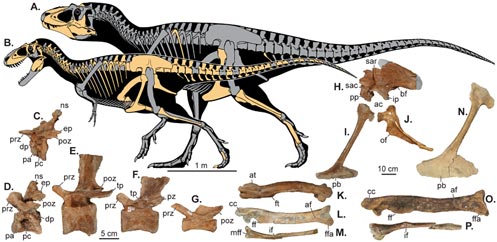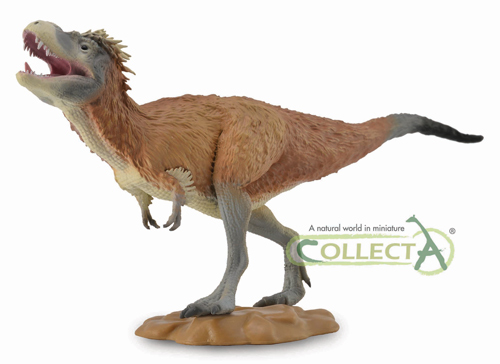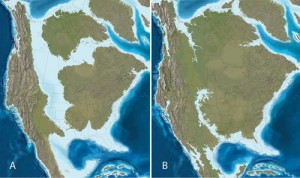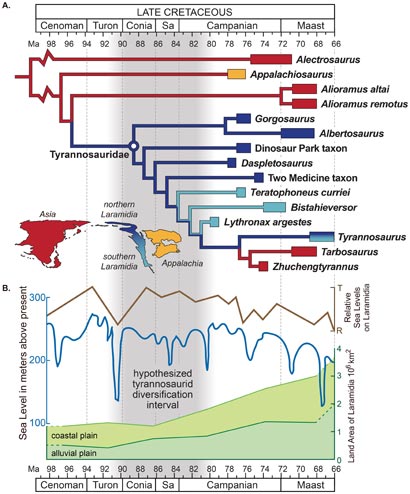Lythronax argestes – New Species of Tyrannosaurid from Southern Utah
An amazing new species of tyrannosaurid has been put on display at the Natural History Museum of Utah (Salt Lake City, Utah). Fossils of this fearsome predator have been excavated from the Grand Staircase-Escalante National Monument in southern Utah. Elements of the skull, jaws and part of the hip indicate an animal approximately eight metres in length. The fossils come from the middle member of the Wahweap Formation and have been dated to approximately 80 million years ago (Middle Campanian faunal stage).
“King of Gore”
This new member of the tyrannosaurid family has been named Lythronax argestes, the creatures’ wide and powerful skull indicate that it was a formidable predator, the genus name means “King of Gore” and the species name is taken from the Greek Homeric wind that blows from the south-west, a reference to the location of the fossil find within North America. The geographical location of this fossil find, has helped palaeontologists to propose a new theory regarding the evolutionary diversification of the tyrannosaurids of the Late Cretaceous. It seems the origins of the likes of Tyrannosaurus rex and Tarbosaurus bataar may be somewhat more provincial than previously thought.
Lythronax argestes
An analysis of the skull of L. argestes indicates that this particular tyrannosaur most likely comes from branch of the Tyrannosauridae that includes T. rex. The snout is short, but stout with the posterior part of the skull quite wide. The orientation and relative position of the orbits suggest powerful stereoscopic vision. Until, this dinosaur was described, palaeontologists had thought that this wide-skulled form of tyrannosaurid only evolved during the very last few million years of the Dinosauria (Maastrichtian faunal stage). Unfortunately, fossilised remains of the forelimbs have not been found to date, so scientists can only speculate on the forelimb proportions and the ratio of upper arm bones to lower arm bones and the digits. The only limb material excavated from the site so far represent elements from the lower left leg.
To view the CollectA Prehistoric Life model collection in stock at Everything Dinosaur: CollectA Prehistoric Life Models and Figures.
Collaborative Authors
The study, funded in large part by the Bureau of Land Management and the National Science Foundation, was led by Dr Mark Loewen, research associate at the Natural History Museum of Utah, and adjunct assistant professor in the Department of Geology and Geophysics at the University of Utah. Additional collaborative authors who worked on this analysis which also covered fossils of another slightly later tyrannosaur called Teratophoneus curriei, include Dr Randall Irmis (Natural History Museum of Utah and Deparment of Geology and Geophysics, University of Utah), Dr Joseph Sertich (Denver Museum of Nature and Science). Also involved were Dr Philip Currie (University of Alberta), and Dr Scott Sampson (Denver Museum of Nature & Science).
Reconstructing the Skeletons of Two of Utah’s Tyrannosaurs

Picture credit: PLoS One/Loewen et al
Teratophoneus curriei
T. curriei is known from more complete fossil material which includes elements from the skull, upper jaw, vertebrae and the hip girdle. This dinosaur was officially named and described in 2011. It was an agile, cursorial predator, perhaps approaching six metres in length. The genus name translates as “monstrous murderer”, the species name honours Philip Currie. Teratophoneus curriei is known from Upper Campanian aged strata (Kaiparowits Formation), of southern Utah, it is a later tyrannosaur, having lived approximately 76 million years ago. Both types of tyrannosaur lived on the huge, isolated landmass that comprises today’s western parts of North America. This landmass is known as Laramidia.
For much of the Cretaceous, North America was split into several landmasses, by the formation of the Western Interior Seaway. Recent studies of the Dinosaurian palaeo-communities that made up the fauna of Laramidia suggest that this part of the world was a hot bed for dinosaur evolution, with many regions supporting their own distinct dinosaur genera. Different parts of Laramidia had similar types of Ornithischian dinosaur but there were differences at the genera level. A lot of debate has taken place over the last couple of years as to why this arrangement of speciation may have come about.
North America During the Late Cretaceous
Picture Credit: Dr Ron Blakey of Colorado Plateau Geosystems, Inc
To read an article that looks at the distribution of horned dinosaurs on Laramidia: A Surge in Mountain Building May Have Caused Laramidia’s Unique Dinosaur Faunas.
Studying Tyrannosaurids
The work of this research team also indicates that the branch of the tyrannosaurids that led to the evolution of Tyrannosaurus rex most likely evolved in relative isolation on the southern portions of Laramidia. Just like with the ornithischian dinosaurs, where plant-eating dinosaurs from the southern part of Laramidia differed from those species found in the northernmost areas, the tyrannosaurids show a similar pattern. Lythronax argestes and its relatives from southern Laramidia are more closely related to each other than the long-snouted tyrannosaurs known from the northern areas of the landmass.
Dr Joseph Sertich, (Denver Museum of Nature and Science), a co-author of the scientific paper that has just been published in the online, academic journal PLoS One, explained:
“Lythronax may demonstrate that tyrannosaurs followed a pattern similar to what we see in other dinosaurs from this age, with different species living in the north and south at the same time.”
In contrast to the research undertaken into the distribution of ornithischian genera, the researchers suggest that mountain building may not have formed the physical barrier that led to the relative isolation of tyrannosaurs that encouraged such speciation and the evolution into a number of different Late Cretaceous forms. For them, rising sea levels may provide the answer.
Dr Randall Irmis, another co-author of this fascinating study, pointed out that by examining the evolutionary relationships, geologic age, and geographic distribution of tyrannosaurid dinosaurs on Laramidia a link can be proposed between tyrannosaurid diversification and the incursion of the Western Interior Seaway. Large parts of Laramidia would have been flooded, leaving isolated islands of dinosaurs, allowing different species of dinosaurs to evolve separated from other groups. A similar example can be taken from the Galapagos Islands of the Pacific, where different species of animal have evolved from a shared, common ancestor, after many thousands of years of separation.
Sea Level Change and the Timing of the Diversification of the Tyrannosauridae
Picture credit: PLoS One/Loewen et al.
As the Seaway retreated, exposing more land, these differences in the local faunas could have been exacerbated by climatic variations, differences in prey components and the flora. This hypothesis helps to explain why the iconic Late Cretaceous dinosaurs of western North America are so different from those of the same age on other continents. tyrannosaurs may have originated in Asia, but it seems that the most famous of them all, Tyrannosaurus rex has its roots in the “good ole southern USA”.
The scientific paper: “Tyrant Dinosaur Evolution Tracks the Rise and Fall of Late Cretaceous Oceans” by Mark A. Loewen, Randall B. Irmis, Joseph J. W. Sertich, Philip J. Currie and Scott D. Sampson published in PLoS One.








Leave A Comment